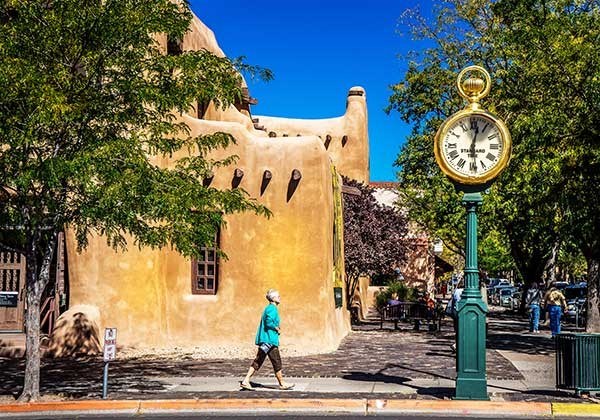Maybe you can find a rubber tomahawk or a Route 66 coffee cup in the stores of Santa Fe. I don't know. I never visited any.
With great confidence, however, I will declare that you can't get any tourist kitsch in Santa Fe for anything shy of an Andy Jackson. That would be a $20 U.S. bill.
"I almost bought a scarf,w" my girlfriend confided when we regrouped. "It was eye-catching, very beautiful."
A frequent visitor to New Mexico over the decades when she was married to an artist in Colorado, she had long before come to appreciate the depth of Santa Fe as a haven for designers and artists. For art, she said, it is quite possibly the most interesting place in North America.
Taos, located about 90 minutes to the north of Santa Fe, draws renegade authors: D.H. Lawrence (Lady Chatterly's Lover) from the Victorian era and John Nichols (Milagro Beanfield War) of the late '60s drop-outs. The visual artists seek to capture the landscapes in this "land of enchantment," as New Mexico calls itself.
Santa Fe goes deeper and wider. The people who have gathered there try to look at the world in new ways. It has the kind of things you just won't find anywhere else.
"Why didn't you buy the scarf?" I asked.
"Would you believe $615 for a scarf?" she explained. "And then I found a sweater-type jacket that was very attractive and well designed, with a turquoise cast to it. It cost $1,045. But the highest price thing we found was a coat that seemed to be made out of patchwork of rags. Would you believe $3,750?"
You can, however, get interesting earrings for just $10 from the Native American pedlars who spread their blankets in front of the Palace of Governors. It is said to be the longest, continuously occupied structure in North America, going back to 1610-1618. That's when the Spanish conquistadors and priests arrived from Mexico to establish a colonial outpost for what is now the American Southwest.
The Spanish who created place names must have been paid by the word. How else do you figure the full, original name: La Villa Real de la Santa Fe de San Francisco de Asís (the Royal Town of the Holy Faith of Saint Francis of Assisi).
The Palace of Governors today is a museum, one of many in Santa Fe devoted to art and history. The history is one of conquest: The Spanish arrived in the early 1600s to subdue the Pueblo Indians. But Mexico broke away from Spain in 1821. Then, in 1847, the United States invaded, fuelled by the ambition of empire that stretched from sea to shining sea.
You can see evidence of all these waves of conquest, starting with the plaza. It accords with the directive of a Spanish king in the 1500s about how towns should be organized.
But those who were conquered left their mark, too. Just off the plaza is the giant Cathedral Basilica of St. Franciso of Assisi. My girlfriend, again my guide, assured me it's not the same sort of Catholic cathedral you would find in New York or Seattle. The Spanish, as they moved northward, incorporated beliefs and symbols of the indigenous peoples, she explained.
The church, unlike most every other building in Santa Fe, has curves. The city's architecture is of adobe, flat roofs and right angles. Even such franchise mainstays as Wendy's and electronics stores kowtow to the regional architectural style.
Santa Fe isn't your traditional mountain town, but it has a ski area 25 kilometres away, in the Sangre de Cristo Range. Somewhat surprisingly, it's the highest state or provincial capital in North America with one notable exception. Mexico City is at 2,250 metres, higher than the 2,100 metres of Santa Fe.
But here's another comparison: Santa Fe, Aspen and Jackson Hole. If they have different price points, I would argue these are the three most interesting towns in the Rocky Mountains. They're all invigorated by ideas, and that, even more important than their surroundings, is what makes them interesting.
My advice on Santa Fe is to go — but don't expect to get by on the cheap.




